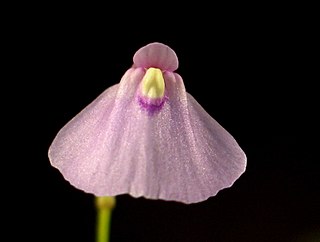
Utricularia dichotoma, commonly known as fairy aprons, is a variable, perennial species of terrestrial bladderwort. The specific epithet is Latin for "dividing into pairs" and refers to the double arrangement of flowers which this species often displays.

Utricularia gibba, commonly known as the humped or floating bladderwort, is a small, mat-forming species of carnivorous aquatic bladderwort. It is found on all continents except Antarctica.

Utricularia multifida, commonly called pink petticoat or fairy aprons, is a terrestrial carnivorous plant that belongs to the bladderwort genus, Utricularia, of family Lentibulariaceae. It is endemic to the south west corner of Western Australia. It was once placed in a separate genus as Polypompholyx multifida.
Utricularia beaugleholei is a terrestrial carnivorous plant that belongs to the genus Utricularia. Its distribution ranges from southeastern South Australia through central and western Victoria into New South Wales, where it has been collected from the southern tablelands and southwest slopes.

Utricularia petertaylorii is an annual terrestrial carnivorous plant that belongs to the genus Utricularia. It is endemic to southwestern Western Australia. It is named in honor of Peter Taylor.
Utricularia quinquedentata is an annual, terrestrial carnivorous plant that belongs to the genus Utricularia. Its distribution ranges across northern Australia from Western Australia to northern Queensland and south to Brisbane. It was first identified by Ferdinand von Mueller as possibly a new species or variety in the early 1890s, noting it as "U. albiflora or a closely allied species." Mueller labeled one herbarium sheet as Utricularia albiflora var. quinquedentata. Without a valid description, according to the rules of botanical nomenclature, however, the epithet quinquedentata was not recognized until Peter Taylor validly published the species in 1986.

Utricularia uniflora is a terrestrial carnivorous plant that belongs to the genus Utricularia. Its distribution ranges across southeastern Australia from extreme southeastern Victoria through New South Wales to southern Queensland. It is also found in Tasmania.

Utricularia volubilis, the twining bladderwort, is a perennial, affixed aquatic carnivorous plant that belongs to the genus Utricularia. It is endemic to the southwestern coastal region of Western Australia.
Utricularia leptoplectra is a terrestrial or subaquatic carnivorous plant that belongs to the genus Utricularia. It is endemic to Australia with a distribution in the Northern Territory from the area around Darwin, east to the Arnhem Land plateau, south to Katherine, and west to the western Kimberley region in Western Australia.
Utricularia limosa is a terrestrial or subaquatic carnivorous plant that belongs to the genus Utricularia. It is endemic to Australia and Southeast Asia with distributions in China, Laos, Malaysia, New Guinea, the Northern Territory, Queensland, Thailand, Vietnam, and Western Australia.

Utricularia aurea, the golden bladderwort, is a medium- to large-sized suspended aquatic carnivorous plant that belongs to the genus Utricularia. It is the most common and widespread suspended aquatic species in Asia. Its native distribution ranges from India to Japan and Australia.
Utricularia muelleri is a medium-sized, perennial suspended aquatic carnivorous plant that belongs to the genus Utricularia. U. muelleri is endemic to Australia and Papua New Guinea.

Utricularia stellaris is a medium to large sized suspended aquatic carnivorous plant that belongs to the genus Utricularia. U. stellaris is native to Africa, tropical Asia, and northern Australia.
Utricularia sect. Enskide is a section in the genus Utricularia. The two species in this section are small to medium-sized terrestrial carnivorous plants native to Australia and New Guinea. Constantine Samuel Rafinesque originally described and published this section as a separate genus in his 1838 taxonomic treatment. Peter Taylor refined the section and placed it within subgenus Utricularia in his 1986 monograph of the genus. Later molecular data resulted in the revision of Taylor's treatment, reinstating subgenus Bivalvaria and placing this section within it.

Utricularia chrysantha, the sun bladderwort, is a medium-sized annual, terrestrial carnivorous plant that belongs to the genus Utricularia. U. chrysantha is endemic to southern New Guinea and Australia. It grows as a terrestrial species in wet grasslands or Melaleuca-Acacia savannas at low altitudes near sea level. It was originally described and published by Robert Brown in 1810.

Utricularia lateriflora, the small bladderwort, is a small to medium-sized perennial carnivorous plant that belongs to the genus Utricularia. U. lateriflora is endemic to Australia and can be found in New South Wales, Queensland, South Australia, Tasmania, and Victoria. It grows as a terrestrial plant in sandy or peaty soils in heathland at lower altitudes. It was originally described and published by Robert Brown in 1810.
Utricularia simmonsii is a small annual or perennial terrestrial carnivorous plant that belongs to the genus Utricularia and is the only member of Utricularia sect. Minutae. U. simmonsii is endemic to Australia and is only known from a few locations in the Northern Territory and Queensland. It and the section Minutae were originally published and described by Allen Lowrie, Ian D. Cowie, and John Godfrey Conran in 2008. It was named in honor of Paul Simmons, who discovered the species in Queensland in 2005.

Utricularia uliginosa, the Asian bladderwort, is a small annual carnivorous plant that belongs to the genus Utricularia. It is native to Southeast Asia, Oceania, and Australia. U. uliginosa grows as a terrestrial or subaquatic plant in seasonally flooded shallow pools with sandy soils or on banks and among rocky stream beds at low altitudes. It was originally described by Martin Vahl in 1804.

Australia has one of the world's richest carnivorous plant floras, with around 187 recognised species from 6 genera.












